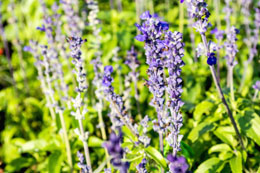Meadow sage is a medicinal herb that lends several benefits which range over the medicinal as well as culinary. Continue reading to learn what these benefits are, and how to care for this plant.

The meadow sage (
Salvia pratensis), also known as Meadow Clary or the Meadow Sage May Night, is a herbaceous perennial plant that belongs to the family of
Lamiaceae. This herb originated in the southern parts of Europe, and has now spread over the western parts of Asia and the northern parts of Africa as well. The herb is not only used for medicinal purposes but for improving the taste of a dish, and for decorating the garden as well. The following sections will contain information on the care and benefits of this herb.
The Physical Features
The meadow sage usually grows up to a height of 35 to 85 cm and is around 50 cm wide (these dimensions are greatly influenced by the environmental conditions). These plants have violet flowers which are arranged around the stem. The colors might vary from a rich violet to a bluish violet, or a pure white to a rose pink. The leaves of this herb are whitish in color with jagged edges, and are arranged on the stalk--one leaf opposite the other. The size of the leaves decreases as one goes higher up the stalk or the branch.
The Benefits
The benefits of this herb are innumerable--it is used for both, culinary, and medicinal purposes. The pleasant aroma of the leaves acts as a flavoring agent in cooking. This herb is also used for curing varied kinds of cuts and sprains, as well as for curing joint pain and ulcers. This is possible due to the inflammatory properties of this herb. The herb also helps improve the memory, and cure the common cold and cough. This herb is a gardener's delight because it attracts butterflies, bees, and even birds to the garden.
Care for the Plant
Before planting the sage in your garden, you should learn about the various ways to take care of them. Given below are some tips.
- These herbs grow best in soil that is well drained and mildly acidic, and has a mildly alkaline pH level.
- The minimum temperature required for its survival is around -3.8 degrees Celsius. This plant is drought resistant.
- The flowers of this herb usually bloom around spring, and continue to bloom throughout summer.
- These herbs require a partly shaded area to grow well. Keeping them in an area where there is no sun will kill these plants.
- The sage is susceptible to certain diseases such as powdery mildew, the verticillium wilt, and rhizoctonia. It therefore becomes important to use fertilizers in order to protect the herb from these diseases.
It is important to note that pregnant women should NOT take this herb.






 The meadow sage (Salvia pratensis), also known as Meadow Clary or the Meadow Sage May Night, is a herbaceous perennial plant that belongs to the family of Lamiaceae. This herb originated in the southern parts of Europe, and has now spread over the western parts of Asia and the northern parts of Africa as well. The herb is not only used for medicinal purposes but for improving the taste of a dish, and for decorating the garden as well. The following sections will contain information on the care and benefits of this herb.
The meadow sage (Salvia pratensis), also known as Meadow Clary or the Meadow Sage May Night, is a herbaceous perennial plant that belongs to the family of Lamiaceae. This herb originated in the southern parts of Europe, and has now spread over the western parts of Asia and the northern parts of Africa as well. The herb is not only used for medicinal purposes but for improving the taste of a dish, and for decorating the garden as well. The following sections will contain information on the care and benefits of this herb.